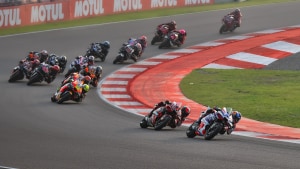What's going to happen to the BIC and MMRT?
When the news broke, it was with a great deal of sorrow that fans in India came to terms with the fact that the Buddh International Circuit wasn't going to host a Formula 1 race in 2014. But was this a bolt out of the blue or was it something that was to be expected? It's a complicated tale, this one and there are many sides to it.
Where did it all start?
The rumblings first made their presence felt at the Hungarian GP, when Bernie Ecclestone told the media that India needed to make up its mind whether it wanted F1 or not. What was the grand old man of F1 referring to? Primarily, the taxation and red tape that has surrounded the Indian Grand Prix. Initially, though, BIC officials denied any such thing, declaring that the Indian GP would go ahead as scheduled. Then the news finally broke that the 2014 race had been cancelled and the event would continue to see out its five-year contract with races in 2015 and 2016.

Why did this happen?
The truth is that Bernie Ecclestone has wanted the Indian GP to run in the first part of the season from the very beginning. Ecclestone wanted India to host the race around the same time as the Australian and Malaysian GP, something that hasn't happened. Of course officials at the BIC have cited reasons such as the fact that March and April were primarily the months where examinations take place in India. This automatically meant a poor turnout at the races. Add to that the fact that the temperatures in New Delhi soar in those months and it wasn't quite conducive to racing. Due to this, the first two editions of the Grand Prix were held in October. However, when Ecclestone insisted the race be moved to March, the JPSI made a request to cancel the 2014 edition of the Grand Prix and allow them to host the event in 2015 and 2016 instead. The reason being once the 2013 edition of the race was done in October, it would leave them very little time to prepare the track for the 2014 event, were it scheduled in March.
"October-November period suits us better both weather-wise as well as it being the festive season, but if Formula One Management wants us to hold our race in March 2015, we don't have any problem with that." Sameer Gaur, MD and CEO, Jaypee Sports International Ltd (JPSI) declared in a release sent out to the media.
What about WSBK, then?
Soon after that, though, it was announced that the final round of the WSBK championship was also being cancelled. Readers will remember that the World Superbike Championship was initially supposed to come to India as the season-opening round in 2013, but eventually got pushed to the season finale to be held on the 17th of November. The initial reason cited for the postponement was the fact that the circuit had never hosted a motorcycle event before, and time would be required to train marshals to ensure that the event ran smoothly, seamlessly and most importantly - safely. Keeping this in mind, though, a decision had been made to run the National Motorcycle Racing Championship at the track ahead of the event. Following that, though, and with the death of rider Andrea Antonelli during the World Supersport race at Moscow, it was decided that there wasn't time enough to adequately prepare marshals for emergency situations and the race was cancelled.
Is there more to it?
Indeed there is. The Buddh International Circuit is a private venture, which means that all the money that has been spent on bringing Formula 1 to India, has come out of JPSI's coffers. This includes approximately $200 million on constructing the track itself and a further $200 million on licensing fees for Formula 1. In addition to this, track maintenance costs close to Rs 4 crore a year. It's not a small amount to be shelling out. But somehow JPSI has managed so far. Meanwhile, there is the fact that motorsport is still not recognised as an official sport by the Government of India. Which means there are no subsidies or tax exemptions that JPSI can hope to cut their losses on. Add to that the fact that between the first year and second year of hosting the event, a drop of nearly 30,000 was seen in terms of attendance (95,000 people attended the 2011 edition of the race, while 65,000 attended the second edition) and things weren't looking so good. With ticket sales for F1 dropping so dramatically, what chance does WSBK have of helping the BIC make some of its money back?
JPSI has a contract to host the Indian GP for five years. With three down at the end of 2013, and two to go, it looks hard for a private group to host the event. Sources say that the company is determined to fulfill its contract come what may, although, hosting the race beyond that might look difficult. As for WSBK, the race might return in 2015. But that's still conjecture. Back to F1, though. Does Ecclestone care about the BIC dropping off the calendar? We doubt it. There are more racetracks being built around the world, each of which might just have a driver of some repute from their country taking to the grid for that event. F1, as a business, is not in any real danger, but the new world racetracks most certainly are.
Meanwhile, down South
Pictures of a new circuit layout of the Madras Motor Racing Track have been doing the rounds for a while now, with OVERDRIVE having seen these images as far back as three years ago. However, it now appears that a timeline has emerged for the racetrack to get a thorough revamp. Speaking to FMSCI President Vicky Chandhok, OVERDRIVE is able to say that the circuit map, which shows the track split into two - the East Circuit and West Circuit, isn't final yet. However, final plans will soon be drawn up. While sources initially indicated there was no real timeline in place for the same, Chandhok has declared that the groundwork has already begun. The work on the MMRT will see a compound wall of close to 5.8 to 6km being built around the periphery of the track, while within three month's time work will begin on the upgraded pit and paddock complex. Moving the start/finish straight and splitting the circuit in a way that it can also function as two independent tracks ought to reach completion within the next 18 months.The cost of the entire project is supposed to be close to Rs 15 crore, while all funding is from within the Madras Motor Sports Club itself. The MMSC has already spent Rs 7 crore on refurbishing the pitlane with wire fencing, and adding 3.2 km of Armco barriers around the track, while also increasing run off areas. "Our goal is to get the MMRT a Grade 2 formal certification for cars and a Grade B certification for motorcycles. We aren't working towards a specific race, but merely doing what finances permit us to do, and attempting to improve facilities for domestic racing." Incidentally, a Grade 2 certification for cars will mean the MMST has the potential to host Formula cars, while a Grade B certification includes Superbike, Endurance, E-Power and Sidecar racing.
What won't be done?
Two things - the surface of the track won't be redone. Chandhok chalks off the bumpy nature of the circuit to soil conditions, also stating that in order to tackle that problem, the track will have to be rebuilt from scratch. In addition, the kerbs are also relatively new and won't be touched at the moment.














